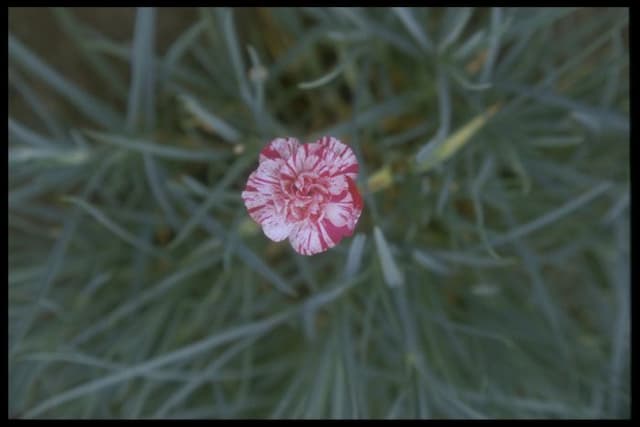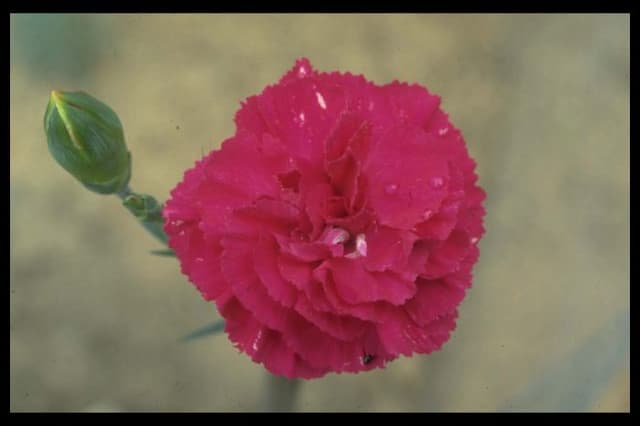Sweet William Dianthus 'Red Star' (PBR) (p)

ABOUT
Dianthus 'Red Star' is an ornamental plant known for its striking appearance, featuring vibrant, deep red flowers that stand out prominently against its backdrop of foliage. The flowers are often characterized by their frilly edges, which add a sense of delicate texture to the visual appeal of the plant. Each bloom is typically composed of five petals, sometimes showcasing a lighter or darker eye in the center, which often adds a two-tone effect to the overall flower color. The blossoms emit a pleasant, spicy fragrance that is particularly noticeable on warm days, making it not just a feast for the eyes but also for the senses. The foliage of Dianthus 'Red Star' is a contrasting grayish-green or blue-green, forming a dense and compact clump. The leaves are slender, with a linear to lance-shaped form, and have a somewhat grassy appearance that creates an attractive, tidy tuft. The contrast between the delicate red petals and the understated foliage color and texture emphasizes the beauty of the flowers, making them even more striking in garden displays or as cut flowers in arrangements. The overall visual effect of Dianthus 'Red Star' is one of vibrant color, delicate textures, and pleasing geometry that can add interest and allure to gardens, borders, and pots.
About this plant
 Names
NamesFamily
Caryophyllaceae
Synonyms
Sweet William, Pinks, Carnation
Common names
Dianthus 'Red Star' (PBR) (p).
 Toxicity
ToxicityTo humans
The Red Star Dianthus is not known to be toxic to humans. While it is generally considered non-toxic, ingestion of any plant material can potentially cause discomfort or an adverse reaction due to individual sensitivities or allergies.
To pets
The Red Star Dianthus is not known to be toxic to pets. This plant is generally considered safe around pets, and there is no widespread evidence of poisoning due to ingestion. However, individual pets may have different reactions, and ingestion of any plant material can potentially cause gastrointestinal upset.
 Characteristics
CharacteristicsLife cycle
Perennials
Foliage type
Evergreen
Color of leaves
Blue-green
Flower color
Red
Height
1 foot (30 cm)
Spread
1 foot (30 cm)
Plant type
Herb
Hardiness zones
6
Native area
Europe
Benefits
 General Benefits
General Benefits- Aesthetic Appeal: Dianthus 'Red Star', commonly known as Pinks, contributes vibrant red flowers that add color and beauty to gardens and landscapes.
- Attracts Pollinators: The flowers of Pinks attract beneficial insects such as bees and butterflies, supporting local ecosystems.
- Low Maintenance: Pinks are known for being easy to care for, requiring minimal upkeep once established in appropriate conditions.
- Drought Tolerance: These plants are relatively drought-resistant, making them suitable for dry climates and water-wise gardens.
- Long Blooming Period: Pinks often have a lengthy flowering season, providing a long display of blossoms throughout the warmer months.
- Versatility: This variety can be used in various settings, including borders, containers, and as ground cover, due to its compact growth habit.
- Fragrance: Many Pinks have a pleasant, spicy fragrance that can enhance the sensory experience of a garden.
- Edible Flowers: The petals of Dianthus flowers are edible and can be used to add color and spice to salads and desserts.
 Medical Properties
Medical PropertiesThis plant is not used for medical purposes.
 Air-purifying Qualities
Air-purifying QualitiesThis plant is not specifically known for air purifying qualities.
 Other Uses
Other Uses- Carnation petals can be crystallized and used as edible decorations on cakes, cupcakes, and desserts, adding a touch of elegance and floral flavor.
- Pressed carnation blooms can be incorporated into handmade papers, giving them a unique and decorative look suitable for invitations or stationery.
- Dried carnation petals can act as a natural dye for fabrics and yarns, providing a range of pink shades depending on the dyeing process.
- Whole carnations can be frozen in ice cubes to create decorative elements for punches and cocktails, offering an attractive and unique presentation.
- Essential oil derived from carnations can be used in homemade candles and soaps for its fragrance, contributing a floral note to the products.
- Carnation petals can be included in potpourri mixes, lending their color and a light fragrance to the mixture.
- As a natural pest repellent, carnation flowers can be used to deter certain insects when planted in gardens or placed near outdoor seating areas.
- Carnations can be used in floral waters or bath infusions for their scent and potential skin-soothing properties, creating a spa-like experience at home.
- These flowers can also be used for crafting eco-friendly confetti, providing a biodegradable option for celebrations.
- Lastly, carnation petals can be sewn into dream pillows or sachets, believed to inspire a peaceful sleep with their soft fragrance.
Interesting Facts
 Feng Shui
Feng ShuiThe Carnation is not used in Feng Shui practice.
 Zodiac Sign Compitability
Zodiac Sign CompitabilityThe Carnation is not used in astrology practice.
 Plant Symbolism
Plant Symbolism- Love and Admiration: Dianthus, commonly referred to as 'Carnations', often symbolizes love and admiration. The 'Red Star' variety, with its vibrant red petals, reinforces this meaning as red is traditionally associated with deep love and affection.
- Distinction and Fascination: Carnations are also known to represent fascination and distinction, which can be attributed to the unique and pronounced patterns of the 'Red Star' blooms that make them stand out.
- Pure Love: In the realm of symbolism, white carnations typically signify pure love and good luck. While 'Red Star' is a red variety, it can still carry the inherent symbolism of its species.
- Good Fortune: Given as gifts, carnations are said to bring good luck and fortune, which can also extend to the Dianthus 'Red Star' when given with positive intentions.
 Water
WaterSweet William requires consistent moisture and should be watered when the top inch of soil feels dry to the touch. It's essential to avoid overwatering, which could lead to root rot. Generally, watering once or twice a week with about one to two gallons of water, depending on the weather and soil drainage, is sufficient. During hot, dry spells, additional water may be needed. Ensure that water is applied directly to the soil rather than overhead to prevent wetting the foliage, which could encourage diseases.
 Light
LightSweet William thrives in full sun to partial shade. It prefers a location that receives at least six hours of direct sunlight daily. Bright, indirect light is also acceptable if the plant cannot be placed in full sun. Avoid locations with full, deep shade as this can reduce flowering and weaken the plant.
 Temperature
TemperatureSweet William is hardy and prefers cooler temperatures but can tolerate a range of conditions. It flourishes in temperatures between 40°F and 70°F but can survive temperatures down to around 20°F and up to 85°F. For ideal growth and flowering, maintain temperatures on the cooler side within the preferred range.
 Pruning
PruningPrune Sweet William to promote bushier growth and encourage more blooms. Deadheading, or removing spent flowers, should be done regularly to extend the blooming period. After the primary bloom in late spring or early summer, cut back the stems to encourage a second flush of flowers. The best time for significant pruning is in late winter or early spring before new growth begins.
 Cleaning
CleaningAs needed
 Soil
SoilThe Sweet William prefers well-drained loam or sandy soil with a pH of 6.0 to 7.5. A mix of one-part garden soil, one-part compost, and one-part coarse sand or perlite is ideal. Ensure good fertility by incorporating slow-release fertilizer or organic matter into the soil before planting.
 Repotting
RepottingSweet William typically does not need frequent repotting; repot once every 2-3 years. It's best to repot when the plant has outgrown its current container or the soil has depleted, usually in the spring before the onset of new growth.
 Humidity & Misting
Humidity & MistingSweet William thrives in moderate humidity levels but is quite adaptable and can tolerate drier air typical of indoor environments. It does not require any special humidity adjustments for optimal growth.
 Suitable locations
Suitable locationsIndoor
Place in bright, indirect light; water when topsoil dries.
Outdoor
Full sun to partial shade; well-drained soil; deadhead spent flowers.
Hardiness zone
3-9 USDA
 Life cycle
Life cycleThe life cycle of the Dianthus 'Red Star', commonly known as Cheddar Pinks, begins with seed germination, typically in early spring under the right conditions of moisture and temperature. During the seedling stage, the plant develops its first true leaves and a root system. As it matures into the vegetative stage, the plant forms a small mound of slender, green to blue-green leaves, focusing on growing foliage and strengthening its root structure. Proceeding to the flowering stage, usually from late spring to early summer, the Dianthus 'Red Star' produces vibrant red flowers with a fragrant, spicy scent, attracting pollinators. After pollination, the plant sets seeds, which can be collected for propagation or left to self-sow in the garden. Finally, as the plant enters dormancy in late fall or winter, it may die back, especially in colder climates, or remain evergreen in milder regions, completing its annual or perennial cycle depending on specific climate conditions and care.
 Propogation
PropogationPropogation time
Spring-Early Summer
Dianthus 'Red Star', commonly known as Cheddar Pink, can be propagated primarily through cuttings, which is the most popular method. This is best done in late spring through summer when the plant is actively growing. Take non-flowering shoots of about 3 to 4 inches (approximately 7.5 to 10 centimeters) long, cutting just below a node. Remove the lower leaves and insert the cuttings into a well-draining soil mix, ensuring at least one node is buried where leaves were removed. Maintain consistent moisture and provide bright, indirect light until roots establish, which typically takes a few weeks. Once rooted and showing new growth, the cuttings can be transplanted into individual pots or their final location in the garden.




![Pink [Coconut Sundae]](/_next/image?url=https%3A%2F%2Fplants-admin.emdemapps.com%2Fimages%2Fplants%2F%2Fimages%2F604b5d09d4fd1.png&w=640&q=75)




